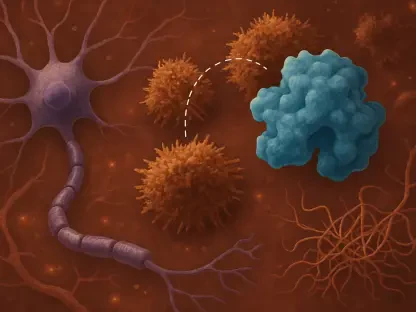Recent research led by scientists at Scripps Research has unveiled groundbreaking insights into the structure and behavior of the protein transthyretin, which could have significant implications for the treatment of transthyretin amyloidosis (ATTR). This disease, marked by the misfolding of transthyretin, results in the formation of harmful clumps in the heart and nerves, leading to symptoms such as shortness of breath, dizziness, and tingling or loss of sensation in the extremities. ATTR is particularly common among older men, affecting up to a quarter of men over the age of 80.
Uncovering Transthyretin’s Asymmetry
Researchers have employed advanced techniques to reveal the three-dimensional asymmetry of transthyretin, shedding light on its instability and potential for misfolding. The study, published in Nature Structural & Molecular Biology on January 22, 2025, opens new pathways for drug development to treat ATTR. Gabriel Lander, PhD, professor at Scripps Research, highlighted that this discovery exposes a previously hidden molecular complexity, enabling the creation of better medicines to stabilize transthyretin.
One of the significant findings of this research is the difference in the two thyroid hormone binding sites on transthyretin, which were previously thought to be identical. This asymmetry explains why a drug binding to one site alters the binding capacity of the opposing site, underscoring the intricate interaction between these sites. Co-senior author Jeffery Kelly, PhD, emphasizes the importance of this discovery in understanding the protein’s behavior, as it opens the door for customized therapies tailored to target these specific binding differences effectively.
Traditionally, researchers had relied on crystallography to determine the structures of small proteins like transthyretin, although this method forces proteins into large, repetitive crystal structures that may not reflect their natural conformations. However, deeper insights were necessary to grasp the underlying mechanisms that contribute to transthyretin’s tendency to misfold, which typically eluded conventional crystallographic analysis. Therefore, an alternative method was sought for a more accurate depiction of transthyretin’s structure in its native environment.
Advanced Techniques in Protein Structure Analysis
Cryo-electron microscopy (cryo-EM) presents an innovative approach that flash-freezes proteins to capture them in more natural states. Despite its advantages, cryo-EM poses challenges when dealing with small proteins, such as transthyretin, as these proteins tend to get stuck at the air-liquid boundary, making them difficult to study accurately. Addressing these challenges required novel solutions to enable precise visualization of transthyretin’s native conformations without the artifacts introduced by traditional techniques.
Lander’s group developed a thin graphene-coated grid that allowed transthyretin molecules to adhere naturally. By rapidly plunging this grid into liquid ethane, they preserved the proteins’ natural conformations, mimicking their behavior in the body’s blood or fluids. This method builds on earlier work from the Yan lab at Princeton, highlighting the importance of surface chemistry in creating high-quality samples. The innovative use of graphene grids in cryo-EM marks a significant advancement in the field, providing researchers with clearer, more accurate images of small protein structures.
Testing this approach revealed asymmetric structures in transthyretin, along with two differently shaped binding pockets, challenging previous assumptions of identical binding sites. The study demonstrated that transthyretin complexes constantly shift between two states, a motion described as molecular “breathing” by Lander. This discovery of structural asymmetry could explain the misfolding and clumping of the protein that leads to disease. Understanding these dynamic shifts in transthyretin’s structure is vital for developing therapies that effectively prevent harmful aggregation.
Implications for Drug Development
The study’s findings have significant implications for drug development, as they uncover the complex dynamics of transthyretin interactions. Attaching the ATTR drug tafamidis, developed by the Kelly lab, to one or both transthyretin binding sites stabilized the molecule and minimized this movement. This stabilization suggests that drugs targeting transthyretin can prevent its destabilization and subsequent disease progression, offering new hope for millions of people suffering from ATTR and related amyloid disorders.
The discovery could lead to the design of new drugs that more effectively stabilize transthyretin, preventing its misfolding and the formation of amyloid fibrils. Furthermore, the ability to visualize transthyretin’s natural conformations using cryo-EM could accelerate the development of these drugs by allowing scientists to test their effects on the protein’s structure in real-time. The researchers’ success in capturing transthyretin’s dynamics plays a critical role in guided drug design, potentially leading to innovative treatments that halt or even reverse the progression of ATTR.
Future Directions and Broader Applications
Recent research by scientists at Scripps Research has revealed groundbreaking insights into the structure and behavior of the protein transthyretin, which may significantly impact the treatment of transthyretin amyloidosis (ATTR). ATTR is a condition caused by the misfolding of transthyretin, leading to the formation of harmful protein clumps in the heart and nerves. This buildup can cause a range of symptoms including shortness of breath, dizziness, and tingling or loss of sensation in the extremities. The disease is especially prevalent among older men, with up to 25% of men over the age of 80 being affected. The new findings could pave the way for more effective treatments, offering hope to many who suffer from this debilitating condition. This revelation not only advances our understanding of the disease but also opens new avenues for research and potential therapies, underscoring the critical role of scientific exploration in combating complex medical conditions.









